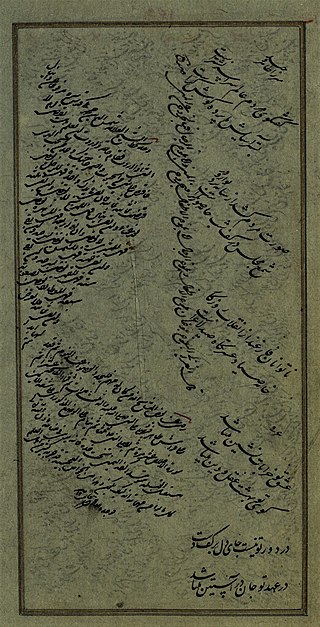Related Research Articles
Shaykh Ali Khan Zanganeh, was an Iranian statesman of Kurdish origin, who served as the grand vizier of the Safavid king (shah) Suleiman I from 1669 to 1689. Due to his efforts in reforming the declining Iranian economy, he has been called the "Safavid Amir Kabir" in modern historiography.

The Treaty of Constantinople, also known as the Peace of Istanbul or the Treaty of Ferhad Pasha, was a treaty between the Ottoman Empire and the Safavid Empire ending the Ottoman–Safavid War of 1578–1590. It was signed on 21 March 1590 in Constantinople. The war started when the Ottomans, then ruled by Murad III, invaded the Safavid possessions in Georgia, during a period of Safavid weakness. With the empire beleaguered on numerous fronts and its domestic control plagued by civil wars and court intrigues, the new Safavid king Abbas I, who had been placed on the throne in 1588, opted for unconditional peace, which led to the treaty. The treaty put an end to 12 years of hostilities between the two arch rivals. While both the war and the treaty were a success for the Ottomans, and severely disadvantageous for the Safavids, the new status quo proved to be short lived, as in the next bout of hostilities, several years later, all Safavid losses were recovered.

The Kar-Kiya dynasty, also known as the Kiya'ids, was a local Zaydi dynasty which mainly ruled over Biya-pish from the 1370s to 1592.

Mirza Mohammad Taqi, better known as Saru Taqi was an eunuch in Safavid Iran, who served as the Grand Vizier of the Safavid king (shah) Safi and the latter's son Abbas II until he was assassinated on 11 October 1645.
Mohammad Beg, was a Muslim of Armenian origin, who served as the Grand Vizier of the Safavid king (shah) Abbas II from 1654 to 1661.

Isa Khan Safavi, also known as Isa Khan Shaykhavand was a Safavid prince, who occupied high offices under king (shah) Abbas I.
Sultan Kalanjar, better known as Gharib Shah, was an Iranian aristocrat who rebelled against Safavid rule in 1629/30, but was defeated and later executed.

Shahqoli Khan Zanganeh, was a Kurdish nobleman, who served as the vizier of the Safavid king (shah) Sultan Husayn from 1707 to 1716.

Mirza Mohammad Taher Vahid Qazvini, was an Iranian bureaucrat, poet, and historian, who served as the grand vizier of two Safavid monarchs, Shah Suleiman and the latter's son Soltan Hoseyn from 1691 to 1699.
Allahverdi Khan was a Safavid military officer of Armenian origin. He was the son of a certain Khosrow Khan, and had a brother named Emamverdi Beg.
Yusuf Āghā was a Safavid gholam and courtier of Circassian origin, who wielded great influence and power during the reign of king Abbas I.
Maryam Begum was a Safavid princess, who was a daughter of shah Tahmasp I and in 1577 married the Kia'i ruler Khan Ahmad Khan—they later had an unnamed son and daughter named Yakhan Begum. Maryam Begum died in 1608/9.
The Khalifeh family, also known as the Khalifeh sayyids, were a branch of the Marashi dynasty of Mazandaran, whose ancestor, Amir Nezam al-Din, had settled in the Golbar quarter of Isfahan in the 15th century.
Mirza Mohammad Mahdi Karaki was an Iranian cleric and statesman, who served as the grand Vizier of the Safavid king (shah) Abbas II, and the latter's son and successor Suleiman I. He was the son of Mirza Habibollah Karaki, who served as the sadr-i mamalik from 1632/3 till his death 1650.

Abdollah Khan Ustajlu was a high-ranking Iranian dignitary of Turkoman origin, who served during the reign of king (shah) Tahmasp I (1524-1576). He successively held the posts of amir al-omarāʾ (commander-in-chief) and divanbegi, before becoming the governor of Shirvan from 1549 until 1565 or 1566.
Anna Khanum was the consort of the Safavid king Safi. She was the mother of her husband's successor, King Abbas II.
Nakihat Khanum was the first wife of the Safavid king (shah) Abbas II.

The province of Khuzestan was a southwestern province of Safavid Iran, corresponding to the present-day province of Khuzestan.
References
- ↑ Peter Charanis. "Review of Emile Janssens' Trébizonde en Colchide", Speculum, Vol. 45, No. 3,, (Jul., 1970), p. 476
- ↑ Women in Iran: From the Rise of Islam to 1800 ed. Nashat and Beck (University of Illinois Press, 2003) p.145
- ↑ Sussan Babaie and others: Slaves of the Shah (I.B. Tauris, 2003) p.104
- ↑ Andrew J. Newman Safavid Iran (I.B.Tauris) p.81
- ↑ Newman 2008, pp. 55, 93, 100.
- ↑ Matthee 2012.
- 1 2 Kissling, H. J.; Spuler, Bertold; Barbour, N.; Trimingham, J. S.; Braun, H.; Hartel, H. (August 1, 1997). The Last Great Muslim Empires. BRILL. p. 210. ISBN 978-9-004-02104-4.